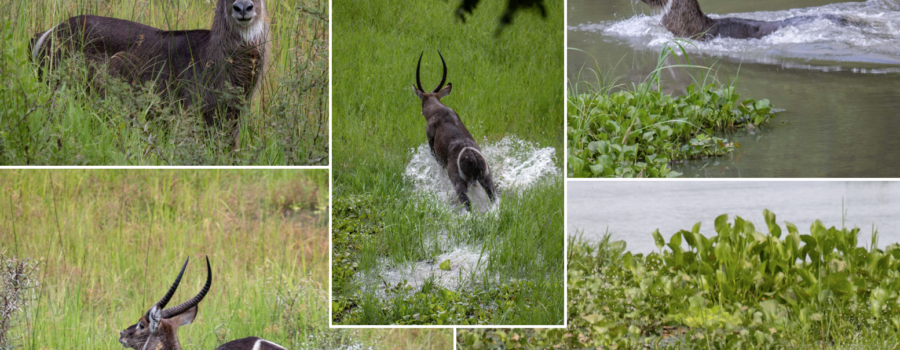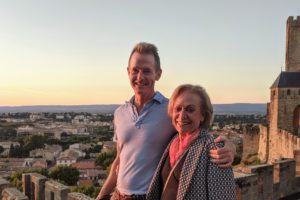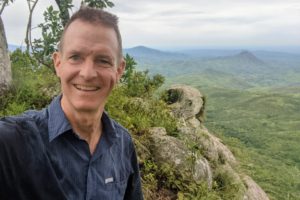After 11 days of clinical service on the Pediatric Research Ward, I was ready for a break. My friends Karen, Jill, and Carl were going to Mvuu Lodge in Liwonde National Park for the weekend. Did I want to come? Uh, yeah! Getting out of the city and into nature was restorative. As a bonus, we had a dramatic, fascinating, and horrifying experience during Saturday’s breakfast.
Liwonde National Park encompasses 212 square miles and is one of several successful Malawian game parks. During the rainy season, like now, access is by a 45 minute boat ride on the Shire (pronounced “Shee-ree”) River. Along the way are hundreds of hippos (“mvuu” is the Chichewa word for hippo), herds of elephants, impala, waterbuck, kudu, and diverse birdlife.
The eight rooms (called “chalets”) at Mvuu Lodge are situated along a deep lagoon that is perpendicular to the faster flowing river. Each room is a huge safari tent on a wooden platform with a terrace projecting 8 feet above the lagoon, perfect for sitting and game viewing. Even though game drives are a daily activity, there is a lot of animal and birdlife right outside in the lagoon and on its banks. Baboons climb the trees, impala and warthogs come to drink, and huge crocodiles patrol the water. The lodge building itself houses a bar and dining area with a large outdoor seating area. Seats are positioned with varying viewpoints over the goings on just below.
Karen and I arrived Friday before our friends and headed off for a game drive that afternoon. We saw a tremendous variety of birds and had close encounters with kudu, zebra, and impala. The roads through the park were muddy and slick and we were happy to have the professional naturalist guide and driver explain things and assure our safety.
By Friday evening, Carl and Jill had arrived and our group of four of us was complete. The following morning, we had a 6 a.m. game drive and returned to the Lodge for breakfast about 9. Breakfast was three courses, as one does in the bush.
We were mesmerized and horrified, awe struck at what we had witnessed.
During the first course, Carl pointed to a loud ruckus across the lagoon. Two male waterbucks, 400-500 pounds each, were running fast and panting loudly, one in close pursuit of the other. Their snorting and heavy breathing let us know this was a fight. Ten seconds after they appeared, they reached the bank of the lagoon immediately opposite our dining area. The pursued animal realized he could not escape and jumped into the shallow but slightly submerged bank, kneeling in the grass and weeds. He kneeled for 15 minutes, long enough to finish our first course, a second cup of coffee, and for the waiter to bring the second.
Abruptly the kneeling, older waterbuck jumped out of the watery weeds, regained the land, and ran as fast as he could in the opposite direction, straight at his pursuer. Instead of locking horns, he ran past. The younger animal turned and was immediately in close pursuit. Realizing he could not outrun his younger foe, the older animal in front jumped into the lagoon, noisily and quickly swimming the 15 feet across, and regaining his footing on our side of the water, just below us.
Over our second breakfast course, we saw the two of them face one another for a long time, each on an opposite bank of the lagoon. The victor snorted and stamped his hooves. After a few minutes of proclaiming his win the younger animal departed, likely to return to his new family, the females he had just won from the older waterbuck who remained looking across the water.
The vanquished waterbuck stood for several minutes. He did not know that if he walked directly towards us (with our recently arrived third breakfast course), he would reach dry land. Instead, he decided he needed to return the way he had come, perhaps to try to retake his family or to live out his remaining days in peace.
When he swam from the opposite lagoon bank towards us, escaping his pursuer, the water was free of vegetation, but the banks were wide apart. Now he looked for a place to cross again, one where the banks of the lagoon were closer together. He decided on a spot about 10 feet to his left where the greenery of the two banks of the lagoon were only a few feet apart. He started walking towards the open water, but it quickly became clear he had misjudged. The green he had taken for dry land was water hyacinths. He jumped into them, up to his neck in vegetation. He swam forward, only his head visible as he moved slowly through the greenery towards the open water, the opposite bank, and safety.
He submerged. When he resurfaced, he was snorting loudly, head thrashing and his beautiful horns twisting in the air as a crocodile repeatedly pulled him under. Thirty seconds later, he was gone.
Breakfast was uneaten and cold. We were mesmerized and horrified, awe struck at what we had witnessed.






